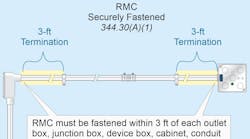Q. What are the disconnect requirements for a building or structure supplied by a feeder?
A. A single disconnecting means for a building/structure must have an ampere rating not less than the calculated load as determined by Art. 220. If the disconnecting means consists of more than one switch or circuit breaker, the combined ratings of the circuit breakers must not be less than the calculated load as determined by Art. 220. In addition, the disconnecting means must not be rated lower than [225.39]:
- For installations consisting of a single branch circuit, the disconnecting means must have a rating of not less than 15A [225.39(A)].
- For installations consisting of two 2-wire branch circuits, the feeder disconnecting means must have a rating of not less than 30A [225.39(B)].
- For a one-family dwelling, the feeder disconnecting means must have a rating of not less than 100A, 3-wire [225.39(C)].
- For all other installations, the feeder or branch-circuit disconnecting means must have a rating of not less than 60A [225.39(D)].



